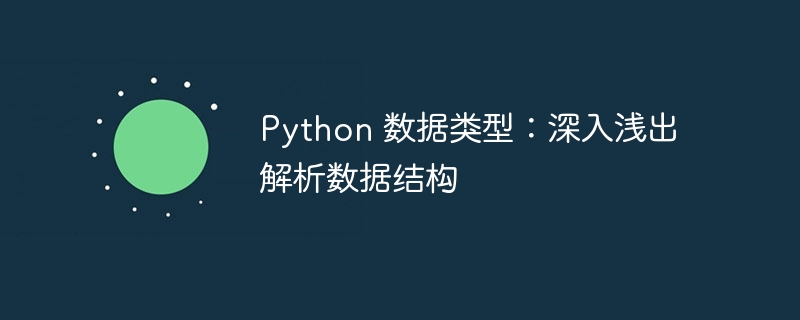Home >Backend Development >Python Tutorial >Python data types: parsing data structures in simple terms
Python data types: parsing data structures in simple terms
- WBOYWBOYWBOYWBOYWBOYWBOYWBOYWBOYWBOYWBOYWBOYWBOYWBforward
- 2024-03-30 12:46:43762browse

- List (list): A collection that stores ordered elements
- Tuple (tuple): An immutable collection that stores ordered elements
- Set (set): A collection that stores unordered and non-repeating elements
- Dictionary (dict): A collection of key-value pairs
3. Data structure
Data structure is a way of organizing data for efficient storage, retrieval and processing of data. python Provides built-in data structures, including:
- Array (array): A linear data structure that efficiently stores elements of the same type
- Linked list: A linear data structure that uses pointers to link elements
- Stack: A linear data structure that follows the last-in-first-out (FILO) principle
- Queue(queue): A linear data structure that follows the first-in-first-out (FIFO) principle
- Tree (tree): Non-linear data structure with hierarchical structure
- Heap: A tree data structure that satisfies the properties of a heap
4. Data type selection
Choosing the appropriate data type is critical to Python the performance and reliability of your program. The following are the selection criteria:
- The size of the data type: affects memory usage and processing speed
- Collection: used to store collections or single elements
- Variability: Whether to allow dynamic modification of the data structure
- Sequentiality: Whether the elements are arranged in a specific order
- Access mode: Different access methods to the data structure (for example, sequential, random)
5. Common mistakes
Common mistakes when using Python data types include:
- Mixed data types: Store different types of data in one data structure
- Using the wrong data structure: Select a data structure that is not suitable for the required operation
- Data structure limit exceeded: Attempt to store data that exceeds its capacity
- Not properly initialized: The data structure was not initialized to appropriate values before use
6. Best Practices
When using Python data types, follow these best practices:
- Choose the appropriate data type: Carefully select the most appropriate type according to your needs
- Clear data type: Clear data type through type annotation or variable declaration
- Consistency: Maintain consistent data type conventions throughout the program
- Avoid uninitialization: Always initialize data structures before use
- Consider performance: Use efficient data structures on large data sets
- Consider maintainability: Choose data structures that are easy to understand and maintain
The above is the detailed content of Python data types: parsing data structures in simple terms. For more information, please follow other related articles on the PHP Chinese website!
Statement:
This article is reproduced at:lsjlt.com. If there is any infringement, please contact admin@php.cn delete
Previous article:Python Variables: Mutable Containers of Data RevealedNext article:Python Variables: Mutable Containers of Data Revealed

